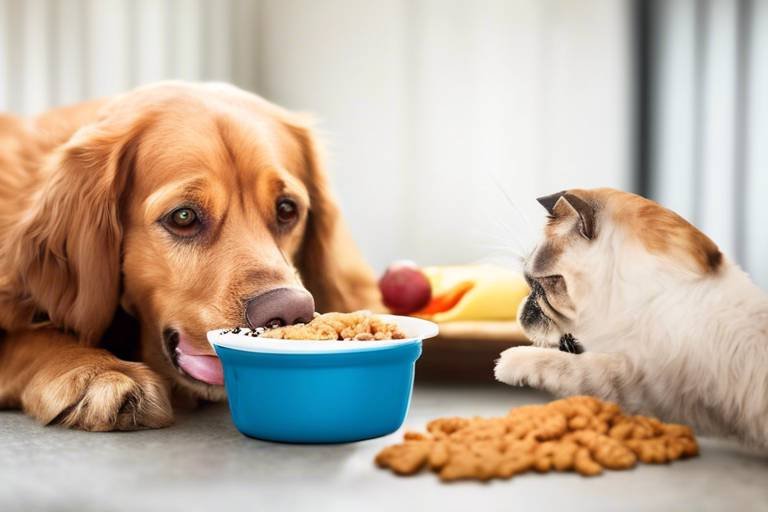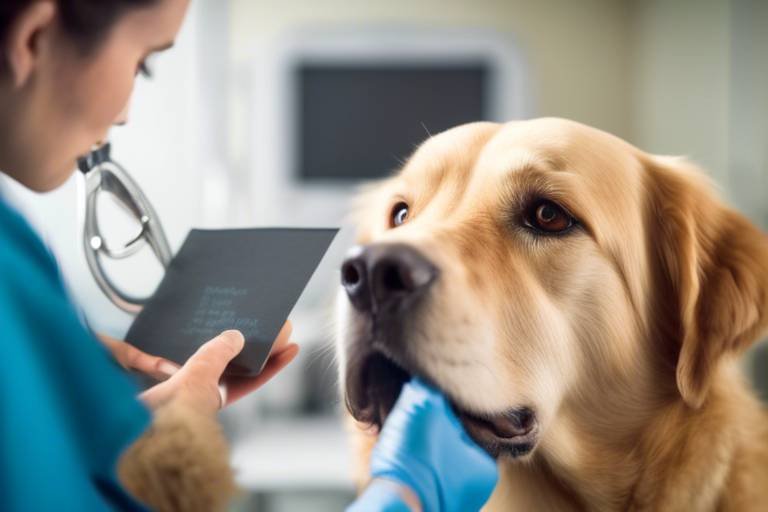The Importance of Environmental Enrichment for Pets
Environmental enrichment is not just a trendy buzzword; it’s a crucial aspect of pet care that can significantly enhance the quality of life for our furry friends. Imagine living in a world where every day feels the same, where there are no exciting new smells to sniff, no toys to play with, and no friends to interact with. Sounds dull, right? That's exactly how pets feel without proper enrichment. By thoughtfully enhancing their environment, we can promote both their physical and mental well-being, ensuring they lead not just longer lives, but happier ones too.
So, what does environmental enrichment actually entail? It encompasses a variety of activities and changes that stimulate our pets’ senses and encourage natural behaviors. This can range from providing engaging toys and interactive games to creating opportunities for social interaction and exploration. Think of it as a way to turn your home into a mini paradise for your pets, filled with challenges and fun that mimic their natural instincts. When we think about how to enrich our pets' lives, we’re not only preventing boredom but also fostering a deeper bond with them.
Now, let’s dive into why this matters so much. Pets, just like humans, can experience stress and anxiety, particularly when they are left alone for long periods or lack stimulation. Environmental enrichment can play a pivotal role in reducing these issues. For instance, dogs that engage in regular playtime and training sessions are less likely to exhibit destructive behaviors, such as chewing on furniture or excessive barking. Similarly, cats that have access to climbing structures and interactive toys are less likely to develop behavioral problems. It’s all about keeping their minds and bodies active!
Moreover, the benefits of environmental enrichment extend beyond just behavior modification. It can lead to significant improvements in physical health. Regular physical activity is vital for maintaining a healthy weight, strengthening muscles, and ensuring cardiovascular health. Just like us, pets need to move around to stay fit and healthy. Enrichment activities can be a fun way to get your pets moving, whether it’s through a game of fetch, an agility course, or simply exploring a new walking route in the neighborhood.
In addition to physical health, mental stimulation is equally important. Engaging pets in problem-solving activities can sharpen their cognitive abilities. Did you know that dogs and cats can learn tricks and solve puzzles just like humans? This mental challenge keeps their brains active and can help prevent cognitive decline as they age. Think of it as a workout for their brains, keeping them sharp and inquisitive.
In summary, environmental enrichment is essential for creating a fulfilling life for our pets. By understanding its importance and implementing various forms of enrichment, we can ensure our furry companions thrive both physically and mentally. So, let’s roll up our sleeves and start transforming our pets' environments into vibrant, stimulating spaces that cater to their needs!
- What is environmental enrichment? Environmental enrichment involves enhancing your pet's environment to provide mental and physical stimulation, promoting overall well-being.
- Why is environmental enrichment important for pets? It helps reduce stress, improves behavior, and enhances cognitive function, leading to happier and healthier pets.
- How can I implement enrichment at home? Simple changes like providing toys, creating play areas, and engaging in interactive games can significantly enrich your pet's life.
- Can environmental enrichment prevent obesity in pets? Yes! By encouraging physical activity through enrichment, you can help your pet maintain a healthy weight.
- What types of enrichment can I provide? You can offer physical, social, and sensory enrichment through activities like agility courses, playdates, and interactive toys.

Understanding Environmental Enrichment
This article explores how environmental enrichment enhances the well-being of pets, discussing various forms of enrichment, its benefits, and practical ways to implement it in daily routines.
Environmental enrichment refers to the process of enhancing an animal's environment to promote physical and mental stimulation. Imagine living in a world where everything is bland and monotonous; it would be utterly boring, right? Well, our pets feel the same way! By introducing various engaging activities and interactions, we can help our furry friends lead healthier, happier lives. This concept is not just about throwing a ball or giving a scratch behind the ears; it encompasses a wide range of activities that challenge and stimulate pets in multiple ways.
At its core, environmental enrichment aims to mimic the natural habitat of pets, providing them with opportunities to express their natural behaviors. For instance, a cat loves to climb, scratch, and hunt, while dogs thrive on social interaction and physical activity. By understanding these needs, we can create an environment that not only meets but exceeds their expectations. This can involve simple changes, like adding climbing shelves for cats or engaging in interactive play for dogs.
Moreover, enrichment can take many forms, including:
- Physical Enrichment: Activities that encourage movement and exercise.
- Mental Stimulation: Puzzles and toys that challenge their cognitive abilities.
- Social Enrichment: Opportunities for interaction with humans and other animals.
- Sensory Enrichment: Introducing new scents, sounds, and textures to keep their senses sharp.
By incorporating these elements, we can significantly improve our pets' quality of life. Think of it as providing a mini-adventure every day! Not only does this prevent boredom and associated behavioral problems, but it also fosters a deeper bond between pets and their owners. When pets are engaged and happy, they are less likely to develop anxiety or destructive habits, making for a more harmonious home environment.
In summary, understanding environmental enrichment is crucial for any pet owner who wants to ensure their furry companions lead fulfilling lives. By recognizing their unique needs and providing diverse activities, we can create a stimulating environment that promotes overall well-being. So, let’s dive deeper into the benefits of such enrichment and discover how we can implement it effectively in our daily routines!
Enrichment provides numerous benefits for pets, including reduced stress, improved behavior, and enhanced cognitive function. Understanding these advantages can motivate pet owners to incorporate enrichment into their pets' lives.
Engaging in stimulating activities helps pets maintain a healthy weight, improve cardiovascular health, and develop strong muscles. Regular exercise through enrichment is crucial for overall physical well-being.
Obesity in pets can lead to serious health issues. Environmental enrichment encourages physical activity, reducing the risk of obesity and promoting a healthier lifestyle for pets.
Regular movement and exercise through enrichment activities contribute to healthier joints and muscles, preventing conditions like arthritis and ensuring pets remain active throughout their lives.
Mental enrichment challenges pets' brains, enhancing problem-solving skills and cognitive abilities. This stimulation is vital for preventing boredom and promoting lifelong learning in pets.
Various forms of enrichment can be implemented, including physical, social, and sensory activities. Understanding these types allows pet owners to tailor enrichment to their pets' specific needs and preferences.
Physical enrichment includes activities that promote movement, such as agility courses, interactive toys, and outdoor play. These activities keep pets active and engaged, ensuring they receive adequate exercise.
Social interactions with humans and other animals provide emotional stimulation. Playdates, training sessions, and family involvement are excellent ways to enhance pets' social lives, fostering better behavior and happiness.
Pet owners can easily incorporate enrichment into daily routines through simple changes. Creative strategies can make a significant difference in pets' quality of life and overall happiness.
Creating homemade toys and puzzles can be a cost-effective way to provide enrichment. Simple items like cardboard boxes and treat-dispensing toys can stimulate pets' curiosity and playfulness.
Pet owners can also seek professional guidance, such as trainers or behaviorists, to develop tailored enrichment plans. These resources can provide valuable insights into enhancing pets' environments effectively.
1. What is environmental enrichment?
Environmental enrichment is the process of enhancing an animal's environment to promote physical and mental stimulation, helping them lead healthier and happier lives.
2. Why is environmental enrichment important for pets?
It is crucial because it prevents boredom, reduces stress, and encourages natural behaviors, leading to improved overall well-being.
3. How can I implement enrichment at home?
You can implement enrichment by providing interactive toys, engaging in play, and creating a stimulating environment with various activities.
4. Can environmental enrichment help with behavioral issues?
Yes, by keeping pets engaged and active, environmental enrichment can reduce anxiety and destructive behaviors.
5. Are there professional resources available for pet enrichment?
Absolutely! Trainers and behaviorists can offer tailored enrichment plans and strategies to enhance your pet's environment.

Benefits of Environmental Enrichment
This article explores how environmental enrichment enhances the well-being of pets, discussing various forms of enrichment, its benefits, and practical ways to implement it in daily routines.
Environmental enrichment refers to the process of enhancing an animal's environment to promote physical and mental stimulation, helping pets lead healthier, happier lives through engaging activities and interactions.
When it comes to our furry friends, ensuring they live their best lives is a top priority. Environmental enrichment plays a crucial role in achieving this goal. By enhancing their surroundings, we can significantly improve their overall well-being. Let's dive into the myriad benefits that come with enriching our pets' environments.
One of the most significant advantages of environmental enrichment is the reduction of stress levels in pets. Just like humans, pets can experience anxiety and stress. Providing them with a stimulating environment helps them feel more secure and relaxed. For instance, when a pet has access to various toys and activities, it distracts them from potential stressors, such as loud noises or changes in routine. As a result, enriched pets are often more content and less prone to behavioral issues.
Moreover, environmental enrichment enhances cognitive function in pets. Engaging in mentally stimulating activities can improve their problem-solving skills and overall brain health. This is especially important for intelligent breeds that thrive on challenges. Just imagine a dog figuring out how to retrieve a hidden treat from a puzzle toy! This kind of mental workout not only keeps them entertained but also promotes lifelong learning.
Additionally, the physical benefits of enrichment cannot be overstated. Pets that engage in regular physical activity through enriched environments tend to maintain a healthy weight, have improved cardiovascular health, and develop stronger muscles. For example, a cat that climbs on a cat tree or a dog that navigates an agility course is not just having fun; they are also exercising vital muscle groups and keeping their joints healthy.
To sum it up, the benefits of environmental enrichment can be categorized into three main areas:
- Reduced Stress: A stimulating environment can help alleviate anxiety and promote relaxation.
- Enhanced Cognitive Function: Mental challenges keep pets sharp and engaged.
- Improved Physical Health: Regular activity helps maintain a healthy weight and supports overall fitness.
Understanding these advantages can motivate pet owners to incorporate enrichment into their pets' lives. By investing time and effort into creating a more engaging environment, you can ensure that your pet not only survives but truly thrives!
Engaging in stimulating activities helps pets maintain a healthy weight, improve cardiovascular health, and develop strong muscles. Regular exercise through enrichment is crucial for overall physical well-being.
Obesity in pets can lead to serious health issues. Environmental enrichment encourages physical activity, reducing the risk of obesity and promoting a healthier lifestyle for pets.
Regular movement and exercise through enrichment activities contribute to healthier joints and muscles, preventing conditions like arthritis and ensuring pets remain active throughout their lives.
Mental enrichment challenges pets' brains, enhancing problem-solving skills and cognitive abilities. This stimulation is vital for preventing boredom and promoting lifelong learning in pets.
Various forms of enrichment can be implemented, including physical, social, and sensory activities. Understanding these types allows pet owners to tailor enrichment to their pets' specific needs and preferences.
Physical enrichment includes activities that promote movement, such as agility courses, interactive toys, and outdoor play. These activities keep pets active and engaged, ensuring they receive adequate exercise.
Social interactions with humans and other animals provide emotional stimulation. Playdates, training sessions, and family involvement are excellent ways to enhance pets' social lives, fostering better behavior and happiness.
Pet owners can easily incorporate enrichment into daily routines through simple changes. Creative strategies can make a significant difference in pets' quality of life and overall happiness.
Creating homemade toys and puzzles can be a cost-effective way to provide enrichment. Simple items like cardboard boxes and treat-dispensing toys can stimulate pets' curiosity and playfulness.
Pet owners can also seek professional guidance, such as trainers or behaviorists, to develop tailored enrichment plans. These resources can provide valuable insights into enhancing pets' environments effectively.
1. What is environmental enrichment?
Environmental enrichment involves enhancing an animal's environment to promote physical and mental stimulation, leading to a happier and healthier life.
2. How can I tell if my pet needs more enrichment?
Signs your pet may need more enrichment include destructive behavior, excessive barking or meowing, and general lethargy or boredom.
3. Can I create enrichment activities at home?
Absolutely! Many enrichment activities can be easily created at home using common household items, such as cardboard boxes, old toys, and food puzzles.
4. How often should I provide enrichment for my pet?
It's best to provide enrichment activities daily, varying them to keep things fresh and exciting for your pet.
Physical Health Improvements
When we talk about the that come from environmental enrichment, it's hard not to get excited! Imagine your furry friend, full of energy and vitality, bounding around the yard or playfully engaging with their favorite toys. Enrichment activities are not just fun; they are essential for maintaining a pet's overall health. Engaging in regular physical activity helps pets maintain a healthy weight, improves cardiovascular health, and builds strong muscles. Think of it this way: just like humans need exercise to stay fit, pets thrive on movement and play.
One of the most significant issues pet owners face today is obesity. Did you know that over 50% of pets are considered overweight or obese? This alarming statistic can lead to serious health problems, including diabetes, heart disease, and even a shorter lifespan. Environmental enrichment plays a pivotal role in combating obesity by encouraging pets to be more active. Simple activities like chasing a ball or navigating an obstacle course can burn calories and keep your pet fit. Here’s a quick look at how enrichment contributes to a healthier lifestyle:
| Benefit | Description |
|---|---|
| Weight Management | Engaging in physical activities helps maintain a healthy weight, reducing the risk of obesity-related diseases. |
| Cardiovascular Health | Regular exercise promotes heart health, ensuring a strong cardiovascular system. |
| Muscle Development | Active play strengthens muscles, improving your pet's overall physical capabilities. |
Moreover, regular movement isn't just about keeping those extra pounds off; it also contributes to joint and muscle health. Think about it: just like us, pets need to keep their joints lubricated and muscles toned. Engaging in enrichment activities helps prevent conditions like arthritis, allowing pets to remain active and playful throughout their lives. When pets engage in activities that encourage stretching, running, and jumping, they develop flexibility and strength, which are crucial as they age.
Incorporating physical enrichment into your pet's routine can be as simple as taking them for daily walks, setting up playdates with other pets, or even creating a DIY agility course in your backyard. These activities not only keep your pet physically fit but also strengthen the bond between you and your furry companion. So, why not make it a habit to include some form of enrichment in your pet's daily life? You'll be amazed at the positive changes in their health and happiness!
- What is environmental enrichment? Environmental enrichment refers to enhancing an animal's environment to promote physical and mental stimulation.
- How does enrichment improve my pet's health? Enrichment helps maintain a healthy weight, improves cardiovascular health, and strengthens muscles.
- Can I create enrichment activities at home? Absolutely! Simple DIY toys and interactive games can provide great enrichment for your pets.
- How often should I engage my pet in enrichment activities? Aim for daily activities that stimulate both their mind and body for optimal health benefits.
Preventing Obesity
Obesity isn't just a human problem; it’s a growing concern for our furry friends too! Just like us, pets can face serious health issues if they carry around extra weight. This is where environmental enrichment plays a vital role. By encouraging pets to engage in physical activities, we can help them stay fit and healthy. Think of it as giving them a fun workout rather than a chore!
When pets are bored, they often resort to snacking out of boredom, which can lead to weight gain. Environmental enrichment provides various activities that promote movement and stimulate their minds, keeping them active and entertained. For instance, setting up an agility course in the backyard or using interactive toys that require them to move can be a game changer. These activities not only burn calories but also enhance their overall well-being.
Here are some effective ways to prevent obesity in pets through environmental enrichment:
- Interactive Play: Engage your pet in playtime with toys that require them to chase, jump, or fetch. This kind of play is not only fun but also burns off excess energy.
- Outdoor Adventures: Take your pets on regular walks or hikes. Exploring new environments stimulates their senses and encourages them to move more.
- Puzzle Feeders: Use feeders that require pets to work for their food. This not only slows down their eating but also encourages physical activity as they manipulate the feeder.
It's essential to monitor your pet's weight regularly and consult your veterinarian about their ideal weight. A healthy diet combined with mental and physical stimulation will go a long way in preventing obesity. Remember, a fit pet is a happy pet!
Q: How often should I engage my pet in enrichment activities?
A: Aim for at least 30 minutes of structured play or enrichment activities daily, depending on your pet's age, breed, and energy level.
Q: Can environmental enrichment help with behavioral issues?
A: Absolutely! Many behavioral problems stem from boredom or lack of stimulation. Enrichment can reduce anxiety and destructive behaviors by keeping your pet engaged.
Q: What if my pet is not interested in toys?
A: Experiment with different types of toys and activities. Some pets may prefer interactive play, while others may enjoy puzzle toys or outdoor exploration. Finding what excites your pet is key!
Q: Are there professional services for pet enrichment?
A: Yes, many trainers and behaviorists offer enrichment programs tailored to your pet's needs. They can provide valuable insights and strategies to enhance your pet's environment.
Joint and Muscle Health
When it comes to our beloved pets, ensuring their is paramount for a long and active life. Just like humans, pets need regular exercise and movement to keep their joints flexible and muscles strong. Engaging in environmental enrichment activities not only makes their lives more enjoyable but also plays a crucial role in maintaining their physical health. Think of it as a workout routine tailored specifically for your furry friends!
Regular movement through various enrichment activities can prevent debilitating conditions such as arthritis, which is common in older pets. By encouraging your pet to engage in play and exploration, you help them build and maintain muscle strength while promoting joint flexibility. Imagine your dog chasing after a ball or your cat pouncing on a feather toy; these simple activities can significantly enhance their physical well-being.
Moreover, studies have shown that pets who participate in regular physical enrichment tend to have better overall health. This includes not just stronger muscles and joints but also improved cardiovascular health and a reduced risk of obesity. For instance, a study revealed that dogs who engage in agility training show better muscle tone and joint stability compared to those who lead a sedentary lifestyle. This highlights the importance of incorporating physical enrichment into your pet's daily routine.
To help you understand the impact of joint and muscle health on your pet's life, consider the following benefits:
- Enhanced Mobility: Regular exercise keeps pets agile, allowing them to move freely and comfortably.
- Reduced Pain: Active pets are less likely to experience joint pain associated with inactivity.
- Improved Quality of Life: Healthy joints and muscles contribute to a happier, more active pet.
In conclusion, prioritizing your pet's joint and muscle health through environmental enrichment is essential. By providing opportunities for exercise and movement, you not only enhance their physical well-being but also enrich their lives. So, next time you think about how to keep your pet entertained, remember that the right activities can make all the difference in their health and happiness!
Q: How often should I engage my pet in enrichment activities?
A: Ideally, you should incorporate some form of enrichment into your pet's daily routine. Aim for at least 30 minutes of active play or exercise each day, but adjust based on your pet's age, breed, and health condition.
Q: What are some easy enrichment activities I can do at home?
A: Simple activities include hide-and-seek with treats, creating obstacle courses with household items, or using interactive toys that challenge your pet's problem-solving skills.
Q: Can environmental enrichment benefit older pets?
A: Absolutely! Older pets can greatly benefit from gentle enrichment activities that promote movement without straining their joints. Always consult your vet for tailored advice based on your pet's specific health needs.
Mental Stimulation and Cognitive Function
Mental stimulation is like a workout for your pet's brain, and just like humans, pets need to flex those mental muscles to stay sharp and engaged. Imagine your furry friend as a little Einstein, constantly exploring and solving puzzles in their environment. When we talk about cognitive function in pets, we're referring to their ability to learn, remember, and adapt to new situations. Just as you might feel sluggish after a day of doing nothing, pets can become bored and disinterested without proper mental challenges. This boredom can lead to destructive behaviors, anxiety, and even depression.
So, how do we keep our pets' minds as active as their bodies? One effective way is through enriching activities that challenge their problem-solving skills and encourage exploration. For instance, interactive toys that require your pet to figure out how to access a treat can be incredibly stimulating. These toys not only keep them busy but also encourage critical thinking. You might be surprised at how quickly your pet catches on, and this learning process is essential for their cognitive development.
Moreover, engaging your pet in training sessions can significantly boost their mental agility. Teaching them new tricks or commands requires focus and concentration, which helps sharpen their cognitive abilities. Think of it as a game of chess; the more you play, the better you get. Similarly, the more you challenge your pet mentally, the more adept they become at navigating their world. This not only enhances their problem-solving skills but also strengthens your bond as you work together towards a common goal.
Incorporating a variety of activities can keep things fresh and exciting. Here are some ideas that can help enrich your pet's mental landscape:
- Hide-and-seek games, where you hide treats around the house for your pet to find.
- Puzzle feeders that require pets to figure out how to get to their food.
- Interactive apps designed for pets that stimulate their senses and encourage play.
In essence, mental enrichment is not just about keeping your pet entertained; it's about nurturing their overall well-being. A well-stimulated pet is a happy pet, and investing time in their cognitive development pays off in the long run. By providing a variety of stimulating activities, you are not only preventing boredom but also enhancing their quality of life. So, let’s get creative and turn your home into a playground for your pet's mind!
Q: How often should I provide mental enrichment for my pet?
A: Ideally, you should incorporate some form of mental enrichment into your pet's daily routine. Even short sessions of 10-15 minutes can make a significant difference.
Q: Can mental stimulation help with behavioral issues?
A: Absolutely! Many behavioral problems stem from boredom or lack of stimulation. Engaging your pet mentally can reduce anxiety and destructive behaviors.
Q: What are some signs that my pet needs more mental stimulation?
A: If you notice your pet becoming lethargic, destructive, or overly vocal, these could be signs that they need more mental engagement in their daily life.

Types of Environmental Enrichment
When it comes to making our furry friends' lives more fulfilling, environmental enrichment plays a pivotal role. It's not just about throwing a ball and calling it a day; it's about creating a rich tapestry of experiences that cater to their natural instincts and needs. There are several types of enrichment that you can implement, each targeting different aspects of your pet's well-being. Let’s dive into the various forms of enrichment that can transform an ordinary day into an extraordinary adventure for your pets!
First up, we have physical enrichment. This type focuses on activities that promote movement and exercise. Think of it as a mini gym for your pet! Activities like agility courses, interactive toys, and even simple outdoor play can significantly boost your pet's physical health. For instance, setting up a small obstacle course in your backyard can challenge your dog while providing a fantastic workout. Not only does this keep them fit, but it also helps them burn off excess energy, leading to a calmer and more relaxed pet at home.
Next, let’s talk about social enrichment. Just like humans, pets thrive on social interactions. Engaging with other pets or humans can greatly enhance their emotional well-being. Organizing playdates with other dogs or even inviting friends over for a little pet party can work wonders for your pet's happiness. Additionally, incorporating training sessions into their routine can strengthen the bond between you and your pet while providing mental stimulation. After all, who doesn’t love a good game of fetch or a fun training challenge?
Then we have sensory enrichment, which is all about engaging your pet's senses. This can include a variety of activities that stimulate their sight, sound, smell, touch, and taste. For example, introducing new scents through scent trails or interactive toys that make sounds can spark curiosity and excitement. You could also create a sensory garden with different textures and smells for your pet to explore. This not only keeps them entertained but also satisfies their natural instincts to explore their surroundings.
To illustrate these types of enrichment, here’s a quick table summarizing each category and its benefits:
| Type of Enrichment | Description | Benefits |
|---|---|---|
| Physical Enrichment | Activities that promote movement and exercise | Improves physical health, reduces boredom |
| Social Enrichment | Interactions with other pets and humans | Enhances emotional well-being, strengthens bonds |
| Sensory Enrichment | Activities that engage the senses | Stimulates curiosity, satisfies natural instincts |
By understanding these types of enrichment, pet owners can better tailor activities to meet their pets' specific needs. Remember, it's all about creating a stimulating environment that encourages exploration and play. Your pet’s happiness and health depend on it!
Q: How often should I provide enrichment activities for my pet?
A: It's ideal to incorporate enrichment activities into your pet's daily routine. Aim for at least 30 minutes of physical and mental stimulation each day, but adjust based on your pet's energy levels and preferences.
Q: Can I use household items for enrichment?
A: Absolutely! Many household items can be transformed into engaging toys and puzzles. For example, cardboard boxes, old socks, and plastic bottles can all be repurposed for fun and stimulating activities.
Q: What if my pet doesn't seem interested in enrichment activities?
A: If your pet isn't engaging with enrichment activities, try varying the types of activities you offer. Some pets prefer physical play, while others may enjoy mental challenges. Pay attention to what excites your pet and adapt accordingly.
Physical Enrichment Activities
When it comes to keeping our furry friends happy and healthy, play a crucial role. These activities are not just about getting your pet to run around; they are about engaging their minds and bodies in ways that mimic their natural instincts. Think of it as a workout session at the gym, but for your pets! Just like us, pets thrive when they have a variety of activities to keep them stimulated and active.
One of the most exciting ways to provide physical enrichment is through agility courses. Imagine setting up a mini obstacle course in your backyard or living room with tunnels, jumps, and weave poles. Not only does this encourage your pet to exercise, but it also enhances their coordination and confidence. You might be surprised at how quickly your pet picks up on these challenges, turning them into a fun and rewarding experience.
Interactive toys are another fantastic option. These toys are designed to engage your pet's mind while keeping them physically active. For example, treat-dispensing toys require your pet to figure out how to get the treats out, providing both a mental challenge and a physical workout as they paw and nudge the toy. Rotating toys regularly can keep the novelty alive and maintain your pet’s interest. Consider a schedule that allows your pet to enjoy a different toy each week, making playtime feel fresh and exciting.
Outdoor play is also essential for physical enrichment. Taking your dog for a hike or letting your cat explore a secure outdoor space can provide them with new sights, sounds, and smells that stimulate their senses. Engaging in play with a frisbee, ball, or even a laser pointer can unleash their inner hunter, making it a thrilling experience for both you and your pet. Remember, the goal is to create an environment where your pet feels encouraged to explore and be active.
Incorporating these activities into your pet's routine doesn’t have to be complicated. Consider the following simple ideas to get started:
- Set up a DIY agility course using household items.
- Invest in interactive toys that challenge your pet physically and mentally.
- Schedule regular outdoor adventures to explore new environments.
Ultimately, the key to successful physical enrichment is variety. Just like humans, pets can get bored with the same activities. By mixing things up and introducing new challenges, you can keep your pet engaged and excited about playtime. Remember, a happy pet is a healthy pet, and physical enrichment activities are a fantastic way to ensure your furry friend leads a fulfilling life!
Q: How much physical activity does my pet need?
A: The amount of physical activity varies by species and breed. Generally, dogs need at least 30 minutes to 2 hours of exercise daily, while cats may benefit from 15-30 minutes of playtime. Always consult with your vet for personalized recommendations.
Q: Can I use everyday items for enrichment?
A: Absolutely! Items like cardboard boxes, old towels, and plastic bottles can be transformed into engaging toys. Just ensure they are safe and free from small parts that could be swallowed.
Q: How do I know if my pet is bored?
A: Signs of boredom can include destructive behavior, excessive barking or meowing, and a lack of interest in activities they usually enjoy. If you notice these signs, it may be time to introduce new enrichment activities.
Social Enrichment Opportunities
When it comes to our furry friends, social enrichment is like a breath of fresh air for their souls. Just think about it: pets, much like humans, thrive on interaction and companionship. Imagine a dog, wagging its tail, eagerly waiting for playtime with its best buddy or a cat, purring contentedly while lounging in the sun next to its favorite human. These moments are not just cute; they are essential for their emotional well-being. Social enrichment opportunities can take many forms, and they are crucial for fostering a happy, well-adjusted pet.
One of the simplest yet most effective ways to provide social enrichment is through playdates with other pets. These gatherings allow pets to engage in natural behaviors like chasing, wrestling, and exploring together. Not only does this enhance their social skills, but it also helps them burn off excess energy, which can lead to better behavior at home. If you’re wondering how to set up a playdate, consider reaching out to friends or neighbors who have pets. Just remember to supervise the interactions to ensure everyone plays nicely!
Training sessions can also serve as a fantastic avenue for social enrichment. Whether it’s basic obedience training or more advanced tricks, these sessions provide mental stimulation and strengthen the bond between you and your pet. Plus, the added element of socializing with other pets and their owners during group classes can make the experience even more enriching. It’s like a fun social club, but for pets!
Another great way to enhance social interactions is through family involvement. Engaging your entire household in activities with your pet can create a rich environment filled with love and attention. Whether it's taking turns feeding, walking, or playing with your pet, these shared experiences foster a sense of belonging and security for your furry friend. Imagine the joy on your pet’s face when everyone gathers for a game of fetch or a cozy movie night together!
Incorporating these social enrichment opportunities into your pet’s routine doesn’t have to be complicated. It can be as simple as scheduling regular outings to the dog park or inviting friends over for a pet-friendly barbecue. The key is to ensure that your pet feels loved, engaged, and part of the family. After all, a happy pet is a well-adjusted pet, and social enrichment plays a vital role in achieving that balance.
- What is social enrichment for pets? Social enrichment refers to activities and interactions that promote social skills and emotional well-being in pets through engagement with humans and other animals.
- How can I tell if my pet needs more social interaction? Signs may include excessive barking, destructive behavior, or withdrawal. If your pet seems restless or bored, it might be time to increase their social activities.
- Are playdates safe for all pets? Generally, yes, but it’s essential to match pets based on size, temperament, and energy levels to ensure a safe and enjoyable experience for everyone.
- Can I provide social enrichment if I have a busy schedule? Absolutely! Even short, quality interactions during your day can make a significant difference in your pet's social enrichment.

Implementing Enrichment at Home
Integrating environmental enrichment into your pet's daily routine doesn't have to be a daunting task. In fact, with just a few creative adjustments, you can transform your home into a stimulating haven for your furry friend. Think of it as adding a splash of color to a black-and-white painting; it can make all the difference! Start by observing your pet's natural behaviors and preferences. Are they curious explorers or playful pouncers? Tailoring enrichment activities to their personalities is key.
One of the easiest ways to begin is by incorporating DIY enrichment ideas. For instance, consider creating a simple puzzle feeder by placing your pet's kibble inside a cardboard box filled with crumpled paper. This not only encourages them to work for their food, simulating their natural scavenging instincts, but also provides mental stimulation. You can also use old socks to create tug toys or hide treats in different corners of the house for a fun scavenger hunt.
Additionally, don't underestimate the power of professional enrichment resources. Sometimes, having an expert’s guidance can open up a world of possibilities. Trainers and behaviorists can help you develop a tailored enrichment plan that takes into account your pet’s unique needs. They can suggest specific activities or tools that might be beneficial, ensuring that you're not just throwing spaghetti at the wall to see what sticks!
Moreover, you can enrich your pet's environment through social interactions. Schedule regular playdates with other pets or involve family members in training sessions. This not only enhances your pet's social skills but also strengthens the bond between your pet and your family. Remember, a happy pet often equals a happy home!
Finally, consider the importance of sensory enrichment. This can be as simple as introducing new scents or sounds into your pet's environment. You could play nature sounds or offer them different textures to explore, like a soft blanket or a rough scratching post. This sensory variety keeps their environment dynamic and engaging.
- What are some quick ways to enrich my pet's environment? Simple changes like rotating toys, using puzzle feeders, and providing different textures can make a big difference.
- How often should I change enrichment activities? It's best to switch things up every week or two to keep your pet engaged and prevent boredom.
- Can I create enrichment activities for different types of pets? Absolutely! Each type of pet has unique needs, so tailor activities to their species and personality.
DIY Enrichment Ideas
Creating DIY enrichment activities for your pets can be an exciting and fulfilling way to enhance their quality of life without breaking the bank. It’s like turning your home into a mini amusement park for your furry friends! The best part? You can use everyday items to make these engaging toys and activities. For instance, a simple cardboard box can become a treasure chest of fun. Cut holes in it and stuff it with crumpled paper or treats, allowing your pet to dig and explore. This not only stimulates their senses but also encourages natural behaviors like foraging.
Another fantastic idea is to make a treat-dispensing toy. You can take an empty plastic bottle, poke some holes in it, and fill it with your pet's favorite treats. As they roll it around, treats will fall out, keeping them entertained and mentally stimulated. Just imagine your dog or cat, tail wagging or purring, as they figure out how to get those tasty rewards! This simple project not only provides fun but also promotes physical activity.
Don’t forget about sensory enrichment! You can create a scent trail using different herbs or spices. Simply sprinkle them on the floor and let your pet follow the scent to find a hidden treat. This taps into their natural instincts and provides a great mental workout. You could even set up a mini obstacle course in your living room using pillows, chairs, and blankets. This encourages physical activity and challenges them to think creatively.
For those who enjoy crafting, consider making a puzzle feeder. You can use muffin tins and tennis balls to create a fun game. Place treats in the muffin cups and cover them with tennis balls. Your pet will have to figure out how to remove the balls to access the treats, providing them with both mental and physical stimulation. The satisfaction they get from solving the puzzle will be rewarding for both of you!
In summary, DIY enrichment activities can be simple yet effective in promoting your pet's well-being. The key is to keep it fun and engaging. Remember, the goal is to provide an environment that encourages exploration, play, and mental engagement. So, get creative and watch your pets thrive!
Q1: How often should I provide enrichment activities for my pet?
A1: It's beneficial to incorporate enrichment activities into your pet's daily routine. Aim for at least 15-30 minutes of engaging activities each day to keep them mentally and physically stimulated.
Q2: Can I use items from around the house for enrichment?
A2: Absolutely! Many household items can be transformed into fun toys or activities, such as cardboard boxes, old towels, and plastic bottles. Just ensure that any items you use are safe for your pet.
Q3: What if my pet doesn't seem interested in enrichment activities?
A3: Each pet is unique, so it may take some experimentation to find what excites them. Try varying the types of activities and observe their reactions. Sometimes, just a little encouragement or playtime with you can spark their interest!
Q4: Are there any professional resources for enrichment?
A4: Yes! Many trainers and behaviorists specialize in pet enrichment. They can provide personalized advice and strategies to enhance your pet's environment based on their individual needs.
Professional Enrichment Resources
When it comes to enriching your pet's life, sometimes it's best to seek guidance from the experts. can provide tailored strategies that suit your pet's specific needs. These resources include trainers, behaviorists, and even specialized pet care facilities that focus on enhancing the overall well-being of animals. By collaborating with professionals, you can ensure that the enrichment activities you implement are not only engaging but also safe and effective.
For instance, certified animal behaviorists can assess your pet's behavior and suggest enrichment activities that cater to their personality and energy levels. They can provide insights into the types of toys that might appeal to your pet, or suggest exercises that can help alleviate any behavioral issues. Additionally, trainers can facilitate group classes that not only offer training but also socialization opportunities, which are crucial for your pet's emotional health.
Moreover, many pet care facilities offer enrichment programs that focus on interactive play and mental challenges. These programs often include:
- Agility courses: Designed to improve physical fitness and coordination.
- Interactive games: Stimulating problem-solving skills.
- Socialization events: Opportunities for pets to interact with others, enhancing their social skills.
Investing time in professional resources can be incredibly beneficial. Not only do they provide a fresh perspective on your pet's needs, but they also offer structured activities that can lead to long-lasting improvements in your pet's behavior and happiness. In the end, the more you know about your pet's needs, the better you can tailor their environment to promote a fulfilling and enriched life.
Here are some common questions pet owners have regarding environmental enrichment:
- What is environmental enrichment? Environmental enrichment involves modifying an animal's environment to enhance their physical and mental well-being through engaging activities.
- How can I tell if my pet needs enrichment? Signs include destructive behavior, excessive barking or meowing, and a lack of interest in play. If your pet seems bored or restless, they may benefit from enrichment.
- Can I create my own enrichment activities? Absolutely! Many DIY enrichment ideas can be created using household items, such as cardboard boxes or treat-filled toys.
- How often should I provide enrichment? Regularly! Aim to incorporate some form of enrichment into your pet's daily routine to keep their minds and bodies stimulated.
Frequently Asked Questions
- What is environmental enrichment for pets?
Environmental enrichment for pets involves enhancing their surroundings to promote physical and mental stimulation. This can include activities and interactions that keep pets engaged, happy, and healthy.
- Why is environmental enrichment important for my pet?
It's crucial because it helps reduce stress, improve behavior, and enhance cognitive function. Just like humans, pets thrive when they have a stimulating environment that challenges them both physically and mentally.
- What are some examples of physical enrichment activities?
Physical enrichment can include agility courses, interactive toys, and outdoor play. Think of it as a workout for your pet that keeps them active and prevents boredom!
- How can I tell if my pet needs more enrichment?
Signs include destructive behavior, excessive barking or meowing, and lethargy. If your furry friend seems restless or bored, it might be time to spice things up with some enrichment activities!
- Can I create DIY enrichment activities at home?
Absolutely! Simple items like cardboard boxes, treat-dispensing toys, or even homemade puzzles can provide great stimulation without breaking the bank.
- Is social interaction part of environmental enrichment?
Yes! Social enrichment through playdates, training sessions, or family involvement helps pets develop better behavior and emotional well-being. It's like having a social life for your pet!
- How often should I provide enrichment for my pet?
Daily enrichment is ideal. Just like you wouldn't want to eat the same meal every day, pets also need variety in their activities to stay engaged and happy.
- Where can I find professional enrichment resources?
You can seek guidance from pet trainers, behaviorists, or even local animal shelters. They can provide tailored enrichment plans to suit your pet's specific needs!



















